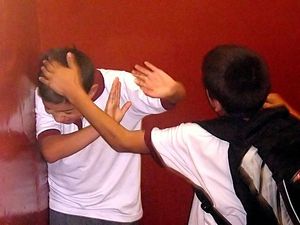Bullying is, unfortunately, something many school children will encounter throughout their lives, whether as a victim, witness, or participant. Below you will learn about bullying, intervention, prevention, and common signs and symptoms a bullied child might display.
What Is Bullying?
To bully someone is to verbally or physically do harm for the purpose of gaining some type of control over a person, generally to use them for something, such as money or attention from peers. To achieve this, a bully must be able to control the victim, thus leading him to the act of bullying. The bully is often older than the victim, but this isn’t always the case.
Signs A Child May Be A Victim Of Bullying
Some of the signs and symptoms of a bullied child include withdrawing, feigning ill to stay home from school, loss of interest in friends or having little or no friends, and loss in self-esteem. Some children may not show outward signs of being bullied, so it is important to stay informed of what is going on in a child’s life every day.
When Should A Parent or Adult Intervene?
If a child successfully stands up to a bully, do not interrupt. Instead, praise the child for his efforts afterward. Then, let the bully know that you will not tolerate that behavior. If the child cannot do it on his own, then intervene further. This might include physically separating the children. Be sure that any intervention includes letting the bully know you will not allow his behavior and let him know that actions will be taken to prevent it.
If the situation occurs at school, a parent should only come to the school to intervene if it is clear that teachers are not controlling the situation. However, never confront your child’s bully, as you will be doing so out of anger. Instead, talk to teachers and staff to form a plan.
Overcoming and Preventing Acts Of Bullying
Bullying can include insulting, teasing, abuse, threats, humiliation, gossiping, rejection, or exclusion. Below are some ways to help your child avoid or overcome these acts.
Having self-esteem and friends can reduce the chances of a child being bullied. Oftentimes, children who are bullied are those who have little or no friends.
Teach a child that although words can sometimes hurt, they cannot let another child’s words hurt them. One positive way for a child to respond to insulting, teasing, or gossiping is to say something nice to the aggressor. Oftentimes, the bully is insulting others because he does not feel good about himself. Your child should be taught to always find positive things to say.
Tell your child to try not to fight back with physical force. Let your child know there are other methods to use, such as walking away, changing the subject, or not upsetting or getting near the bully to begin with. Be sure your child will report any abusive incident or threat to an adult right away.
A child who walks home from school should know several ways to get to his home. This way, he or she can take a different route to avoid a bully, if necessary. Gaining permission to leave school slightly early can also help to avoid a bully.
When a threat or attack is made, your child should not let the bully see that he is upset or affected in any way by the threat, even if he is. Teaching your child how to gain his composure, rather than giving in to control will go a long way in preventing and dispelling a bullying situation.





